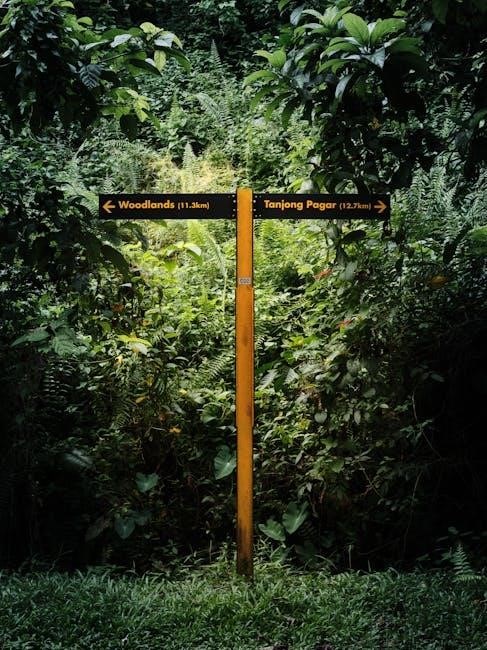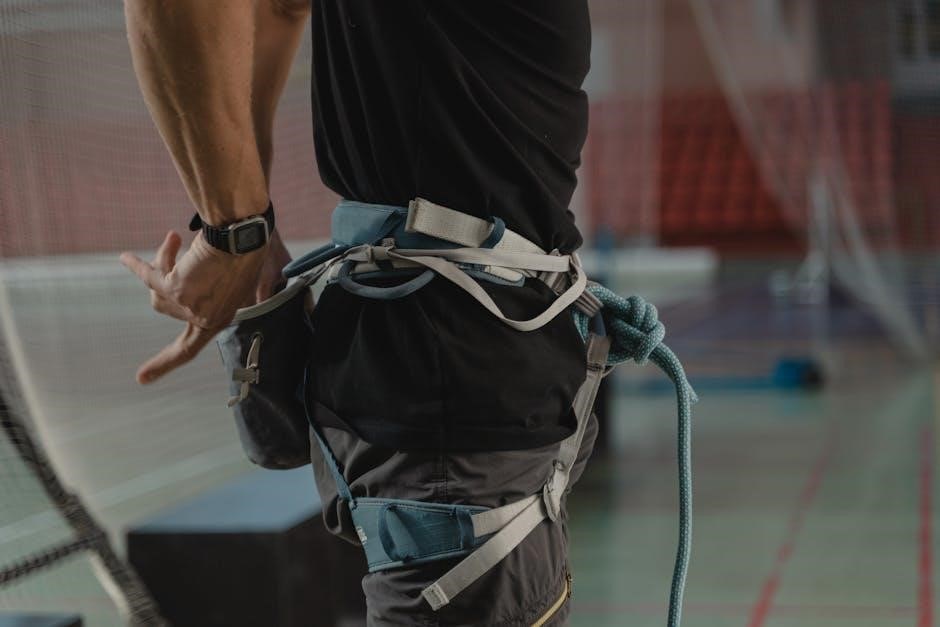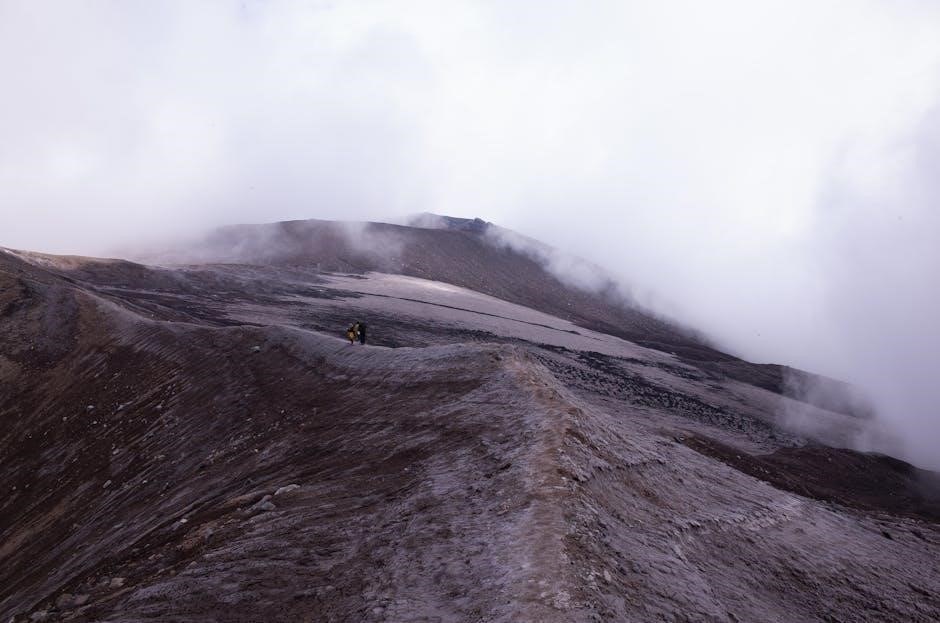Written by Andrew Biel‚ Trail Guide to the Body is a renowned textbook teaching musculoskeletal anatomy and palpation‚ with over 850‚000 copies sold worldwide.
Overview of the Book and Its Significance
Trail Guide to the Body by Andrew Biel is a groundbreaking textbook that has revolutionized the study of musculoskeletal anatomy and palpation. With over 850‚000 copies sold worldwide‚ it is widely regarded as the gold standard in its field. The book is designed for healthcare professionals‚ students‚ and practitioners‚ offering a hands-on approach to understanding the human body. Its significance lies in its ability to make complex anatomical concepts accessible through clear‚ detailed descriptions and practical techniques. The 6th edition continues to build on this legacy‚ incorporating modern tools like palpation videos‚ overlay images‚ and mobile apps. Published by Books of Discovery‚ it remains an essential resource for over 2‚000 programs globally‚ solidifying its role as a cornerstone in anatomy education.
Andrew Biel: The Author and His Expertise
Andrew Biel is a renowned author and massage practitioner with deep expertise in musculoskeletal anatomy and palpation. His work‚ Trail Guide to the Body‚ has become a cornerstone in anatomy education‚ with over 850‚000 copies sold worldwide. Biel’s ability to simplify complex anatomical concepts has made his book indispensable for healthcare professionals and students. He is also the author of the award-winning Trail Guide to Movement‚ further cementing his reputation as a leading voice in the field. Biel’s practical‚ hands-on approach and commitment to effective learning have made him a trusted guide for thousands of learners worldwide‚ ensuring his work remains a vital resource for anatomy education and clinical practice.
The Title: Why “Trail Guide to the Body?”
The title Trail Guide to the Body reflects the book’s purpose as a navigational tool for understanding human anatomy. Just as a trail guide maps out a journey‚ this book guides learners through the complex terrain of the body‚ making musculoskeletal anatomy accessible. The title emphasizes practical exploration‚ aligning with the book’s hands-on approach to palpation and anatomical discovery. It suggests that mastering anatomy is an educational journey‚ and the book serves as a reliable companion‚ providing clear directions and insights. This metaphor underscores the idea that anatomy learning is an active‚ engaging process‚ much like navigating a trail‚ requiring guidance and practice to fully comprehend the body’s structures.

The Core Content of the Book
Trail Guide to the Body focuses on musculoskeletal anatomy‚ offering in-depth coverage of muscles‚ bones‚ and other structures. It provides practical palpation techniques and clear‚ detailed illustrations to help learners develop skills in manual therapy and anatomical understanding. The book emphasizes hands-on exploration‚ making complex concepts accessible for students and professionals in healthcare and bodywork fields. Its comprehensive approach bridges theory and practice‚ fostering a deeper connection with the human body’s structure and function.
A Hands-On Guide to Musculoskeletal Anatomy
Trail Guide to the Body provides a detailed‚ hands-on approach to understanding musculoskeletal anatomy‚ focusing on the practical identification and palpation of muscles‚ bones‚ and connective tissues. It combines clear‚ concise text with precise illustrations to guide learners through the anatomy of each region‚ from the superficial layers to deeper structures. The book emphasizes functional anatomy‚ helping readers understand how muscles work together to produce movement. Its systematic organization allows users to explore the body region by region‚ making it an invaluable resource for both students and practitioners in fields like massage therapy‚ physical therapy‚ and bodywork. This approach ensures a deep‚ tactile understanding of the human body’s structure and function;
Locating Muscles‚ Bones‚ and Other Structures
Trail Guide to the Body excels in teaching the precise location of muscles‚ bones‚ and other anatomical structures through detailed descriptions and illustrations. The book uses palpation techniques and surface anatomy to help learners identify landmarks‚ such as bony prominences and tendons. It provides a systematic approach to exploring each body region‚ guiding readers to locate structures layer by layer. Clear instructions and visual aids enable users to pinpoint muscles‚ ligaments‚ and fascia with accuracy. This focus on localization is essential for healthcare professionals‚ ensuring effective assessment and treatment. The book’s clarity and practicality make it a trusted resource for mastering the spatial relationships of the human body’s musculoskeletal system.
Palpation Techniques: A Key Focus
Trail Guide to the Body places a strong emphasis on palpation techniques‚ providing detailed guidance on how to accurately assess soft tissue‚ muscles‚ and bones. The book offers step-by-step instructions on applying the right pressure and identifying tissue responses‚ ensuring safe and effective practice. Readers learn to distinguish between healthy and restricted tissues‚ a skill crucial for diagnosis and treatment. Biel’s expertise shines through in his ability to simplify complex palpation methods‚ making them accessible to students and professionals alike. The text is complemented by visuals and practical exercises‚ helping learners master these techniques. This focus on palpation underscores its importance in hands-on therapies‚ equipping practitioners with the skills needed for precise and effective care.
The Importance of Anatomy in Healthcare
Trail Guide to the Body highlights the critical role of anatomy in healthcare‚ emphasizing its relevance for accurate diagnosis and effective treatment. Understanding the structure and function of the body is essential for healthcare professionals to identify abnormalities‚ plan interventions‚ and improve patient outcomes. Anatomy serves as the foundation for preventive care‚ enabling practitioners to address issues before they escalate. By mastering anatomical knowledge‚ professionals can deliver personalized treatments tailored to individual needs. This expertise is particularly vital in fields like physical therapy‚ massage therapy‚ and orthopedics‚ where a deep understanding of musculoskeletal anatomy is indispensable. The book underscores how anatomy is not just a theoretical concept but a practical tool for enhancing patient care and overall well-being.

Editions and Publications
Trail Guide to the Body is now in its 6th edition‚ published by Books of Discovery since 1997. Available in print (ISBN: 0982663254) and eBook formats‚ it has sold over 850‚000 copies worldwide‚ becoming a trusted resource for anatomy education across various healthcare disciplines.
Trail Guide to the Body: 6th Edition Details
The 6th edition of Trail Guide to the Body‚ published by Books of Discovery in 2020‚ is the latest iteration of this widely acclaimed textbook. It features updated musculoskeletal anatomy content‚ with over 1‚000 illustrations‚ including new muscle drawings and palpation visuals. The edition includes expanded sections on fascia‚ movement‚ and the latest anatomical research‚ ensuring it remains a cutting-edge resource. It is available in hardcover (640 pages) and digital formats‚ catering to both traditional and modern learners. The 6th edition retains its user-friendly design while introducing new study tools to enhance learning. Its release has further solidified the book’s reputation as an indispensable guide for students and professionals in healthcare and movement fields.
ISBNs and Formats: Print‚ Digital‚ and eTextbook
Trail Guide to the Body is available in multiple formats to meet diverse learning preferences. The 6th edition hardcover book has an ISBN of 978-0-9658535-6-1. For digital learners‚ the eTextbook offers a portable‚ searchable version accessible on devices. Additionally‚ a digital bundle includes the eTextbook‚ overlay images‚ and palpation videos. The book is also available in print‚ ensuring tactile learners can benefit from its detailed illustrations. This variety of formats ensures accessibility for students‚ professionals‚ and educators worldwide‚ catering to different study styles and preferences. Each format maintains the book’s renowned clarity and depth‚ making it a versatile resource for anatomy education. This flexibility has contributed to its widespread adoption across various healthcare disciplines.
Books of Discovery: The Publisher and Their Role
Books of Discovery‚ the publisher of Trail Guide to the Body‚ specializes in creating high-quality educational resources for anatomy and healthcare professionals. Since 1985‚ they have focused on producing materials that simplify complex anatomical concepts‚ making them accessible to students and practitioners. Their commitment to accuracy and clarity has made them a trusted name in the field. By investing in thorough research and updates‚ Books of Discovery ensures each edition of Trail Guide to the Body remains a cutting-edge tool for learning musculoskeletal anatomy. Their dedication to excellence has significantly contributed to the book’s widespread adoption and reputation as an essential resource for hands-on anatomy education.

Features and Benefits
The book offers a user-friendly approach‚ detailed visuals‚ and practical applications‚ making it a comprehensive guide for anatomy enthusiasts and professionals‚ enriching their learning experience.
Exclusive Access to Study Tools
Trail Guide to the Body provides readers with exclusive access to a wide range of study tools designed to enhance learning and retention. These resources include a companion website featuring interactive flashcards‚ self-test exercises‚ and video demonstrations of palpation techniques. Students can also access downloadable content such as muscle charts and bone identification guides‚ which are invaluable for hands-on practice. Additionally‚ the book offers cross-platform compatibility‚ allowing users to access study materials on both desktop and mobile devices. These tools are carefully curated to support anatomy education‚ making complex concepts more approachable and engaging. By combining visual‚ tactile‚ and digital learning methods‚ Trail Guide to the Body ensures a comprehensive and effective study experience for its users;
Palpation Videos and Interactive Resources
Trail Guide to the Body offers an extensive library of palpation videos and interactive resources to deepen understanding of musculoskeletal anatomy. The videos provide clear demonstrations of techniques for identifying muscles‚ bones‚ and ligaments‚ allowing learners to visualize and replicate the methods. Interactive resources‚ such as 3D models and quizzes‚ further enhance engagement by enabling users to explore anatomical structures in detail. These tools are particularly beneficial for healthcare students and professionals‚ as they bridge the gap between theoretical knowledge and practical application. The resources are designed to be user-friendly‚ with step-by-step instructions and real-time feedback to ensure mastery of palpation skills. This combination of visual and hands-on learning makes anatomy more accessible and memorable for everyone.
Overlay Images and Mobile Apps
Trail Guide to the Body features innovative overlay images that allow users to explore musculoskeletal anatomy in layers. These images provide a detailed‚ visual understanding of how muscles‚ bones‚ and other structures interact. The accompanying mobile apps offer a portable and interactive learning experience‚ enabling users to study anatomy anytime‚ anywhere. The apps include interactive quizzes‚ flashcards‚ and the ability to zoom in on images for precise details. This combination of visual and tactile learning tools enhances retention and makes complex anatomical concepts more accessible. The integration of technology with traditional content ensures that learners have a comprehensive and modern approach to mastering musculoskeletal anatomy‚ making it an invaluable resource for both students and professionals.
Convenience and Accessibility of Resources

Trail Guide to the Body prioritizes convenience and accessibility‚ ensuring resources are readily available to learners. The book’s digital components‚ including the eTextbook and mobile apps‚ allow users to access study materials on multiple devices. Online platforms provide a centralized hub for downloading tools‚ eliminating the need for physical storage. This flexibility is especially beneficial for students and professionals who require quick access to anatomical information. The seamless integration of digital and print resources ensures that learners can study efficiently‚ whether in a classroom‚ clinic‚ or remote setting. This accessibility enhances the overall learning experience‚ making it easier to master musculoskeletal anatomy in a fast-paced‚ dynamic environment.

Impact and Reception

Trail Guide to the Body has become a cornerstone in anatomy education‚ widely praised for its clarity and practicality. With over 850‚000 copies sold‚ it is a testament to its enduring relevance and effectiveness in training healthcare professionals worldwide.
Popularity and Sales: Over 850‚000 Copies Sold
Trail Guide to the Body has achieved remarkable success‚ with over 850‚000 copies sold worldwide. Its popularity stems from its unique approach to musculoskeletal anatomy‚ making it accessible to students and professionals alike. The book’s clear instructions‚ paired with detailed illustrations‚ have made it a standard text in massage therapy‚ physical therapy‚ and other healthcare programs. Its widespread adoption across 2‚000 programs globally underscores its reputation as an essential learning tool. The book’s practical focus on palpation and anatomy has resonated with learners‚ establishing it as a trusted resource in the field. This impressive sales milestone reflects its enduring value in healthcare education and practice.
Adoption by Over 2‚000 Programs Worldwide
Trail Guide to the Body has been adopted by more than 2‚000 educational programs globally‚ solidifying its role as a cornerstone in healthcare education. Its widespread integration into curricula reflects its effectiveness in teaching musculoskeletal anatomy. Many massage therapy‚ physical therapy‚ and chiropractic schools rely on the book due to its clarity and practical approach. Educators praise its ability to bridge theoretical knowledge with hands-on practice‚ making it indispensable for students. The book’s universal appeal lies in its accessibility‚ catering to learners at all skill levels. This extensive adoption highlights its influence on shaping the next generation of healthcare professionals‚ ensuring a strong foundation in anatomy and palpation skills.
Awards and Recognition in the Field
Trail Guide to the Body has garnered numerous accolades‚ solidifying its reputation as a premier educational resource. It has received the Excellence in Publishing Award from the American Massage Therapy Association and has been recognized as a finalist in the US Book News Best Book Awards. These honors reflect the book’s clarity‚ depth‚ and practicality in teaching anatomy. Professionals and educators alike praise its ability to make complex concepts accessible‚ earning it a reputation as one of the most trusted textbooks in the field. Its widespread recognition underscores its impact on healthcare education and its role in advancing the understanding of musculoskeletal anatomy.
Testimonials from Healthcare Professionals
Trail Guide to the Body has earned praise from healthcare professionals worldwide. Physical therapists‚ massage therapists‚ and educators frequently commend its clear‚ practical approach to anatomy. One physical therapist noted‚ “This book transformed how I understand and explain musculoskeletal structures to patients.” Educators highlight its effectiveness in teaching complex concepts‚ with one professor stating‚ “It’s the go-to resource for both students and practitioners.” Professionals appreciate its hands-on focus‚ which bridges the gap between theoretical knowledge and real-world application. Testimonials consistently emphasize its indispensability as a tool for improving diagnostic and treatment skills. Such widespread acclaim underscores its role as a cornerstone in anatomy education and practice.

Study Tools and Resources
Trail Guide to the Body offers exclusive tools like palpation videos‚ overlay images‚ and mobile apps‚ enhancing learning through interactivity and convenience.
Empowering Students with Free Study Materials
Trail Guide to the Body provides complimentary study tools‚ enhancing student learning through flashcards‚ practice exams‚ and technique guides. These resources‚ offered by Books of Discovery‚ are accessible online‚ ensuring convenience for students to review anatomical terms‚ muscle groups‚ and palpation methods anytime. The flashcards aid in memorization‚ while practice exams help assess knowledge‚ guiding focused study. Technique review guides offer step-by-step instructions for refining hands-on skills. These materials empower students by providing essential tools for academic success and clinical proficiency‚ making them invaluable for both classroom and practical training.
Online Repository: What’s Included?
The Trail Guide to the Body online repository offers a comprehensive suite of resources designed to enhance learning; It includes over 1‚000 images‚ palpation videos‚ and interactive quizzes to test anatomical knowledge. The 6th edition features a dedicated website and mobile app‚ providing easy access to study aids. Students can explore detailed muscle and bone overlays‚ helping to visualize complex structures. Additionally‚ the repository offers technique videos demonstrating proper palpation methods‚ ensuring accurate hands-on practice. These resources are seamlessly integrated with the textbook‚ creating a dynamic and engaging learning experience. The online platform is regularly updated‚ ensuring students have the most current tools for mastering musculoskeletal anatomy.
Interactive Mobile Apps for Learning
The Trail Guide to the Body interactive mobile apps provide a dynamic learning experience‚ offering 3D models‚ quizzes‚ and flashcards to master musculoskeletal anatomy. These apps allow users to explore muscles‚ bones‚ and ligaments in detail‚ with layered dissections for deeper understanding. Quizzes test knowledge of muscle origins‚ insertions‚ and actions‚ while flashcards reinforce terminology. The apps are compatible with iOS and Android‚ ensuring accessibility on-the-go. Offline access enables learning without internet connectivity. Designed for students and professionals‚ these tools enhance retention and practical application of anatomical knowledge. The apps are regularly updated‚ aligning with the latest edition of the textbook for a seamless learning experience.
Convenience of Access: Anytime‚ Anywhere
The Trail Guide to the Body offers unparalleled convenience‚ allowing users to access its wealth of resources anytime and anywhere. The book is available in multiple formats‚ including print‚ digital‚ and eTextbook versions‚ catering to diverse learning preferences. Digital resources‚ such as palpation videos and interactive tools‚ can be accessed via mobile apps‚ ensuring that students and professionals can study on-the-go. Offline access is also available‚ enabling learning without internet connectivity. The content is optimized for tablets‚ smartphones‚ and laptops‚ providing flexibility across devices. This accessibility makes it easier for learners to integrate anatomy study into their busy schedules‚ fostering continuous education and skill development in healthcare fields.

Community and Support
Trail Guide to the Body fosters a strong community through Andrew Biel’s active engagement‚ offering forums‚ webinars‚ and a mobile app for collaborative learning and support.
Andrew Biel’s Role in Coaching Students
Andrew Biel plays a pivotal role in coaching students‚ extending beyond his book to provide personalized guidance and mentorship. Through webinars‚ workshops‚ and interactive digital platforms‚ he shares practical insights and tips for mastering musculoskeletal anatomy. Biel emphasizes hands-on learning‚ encouraging students to engage with real-world applications of the material. His coaching philosophy focuses on breaking down complex concepts into manageable‚ digestible parts‚ ensuring learners of all levels can succeed. By fostering a supportive environment‚ he empowers students to develop confidence in their understanding and application of anatomy. This dedication to student success has made him a trusted resource in the field‚ complementing the Trail Guide to the Body with dynamic‚ interactive learning opportunities.
Expert Guidance for Effective Practice
Andrew Biel offers expert guidance that enhances the practical application of anatomical knowledge‚ making complex concepts accessible. His teachings emphasize precise palpation techniques‚ ensuring students can accurately identify and assess musculoskeletal structures. Biel’s extensive experience as an anatomist and educator allows him to address common challenges learners face‚ providing clarity and confidence. He advocates for a systematic approach to study‚ encouraging active learning through observation‚ touch‚ and repetition; By bridging theory and practice‚ Biel equips healthcare professionals and students with the skills necessary for effective patient care. His guidance not only deepens understanding but also fosters proficiency in real-world clinical settings‚ making him a trusted authority in the field.
Building a Community of Learners
Andrew Biel’s work extends beyond the textbook‚ fostering a vibrant community of learners passionate about anatomy and healthcare. Through forums‚ social media‚ and workshops‚ Biel encourages collaboration and knowledge-sharing among students‚ instructors‚ and professionals. His engaging approach creates a supportive environment where learners can connect‚ ask questions‚ and grow together. By promoting shared learning experiences‚ Biel helps reduce the isolation often associated with in-depth study. This sense of community not only enhances understanding but also inspires continuous learning and professional development. The result is a global network of individuals united by a common goal: mastering musculoskeletal anatomy for better patient care and practice.
Engagement Through Digital Platforms
Andrew Biel’s Trail Guide to the Body enriches the learning experience through engaging digital platforms designed for anatomy enthusiasts. Online forums and social media groups provide global spaces for students and professionals to collaborate and share knowledge. Regular webinars and live Q&A sessions with Biel and industry experts offer real-time interaction‚ enhancing understanding of complex topics. Multimedia content‚ such as videos and podcasts‚ is frequently updated to keep the community informed and engaged. These platforms not only broaden access to resources but also foster a supportive global network‚ ensuring continuous learning and professional development in musculoskeletal anatomy. This digital engagement strategy has proven instrumental in creating a vibrant‚ interconnected community of learners.

Trail Guide to the Body by Andrew Biel is a transformative resource in anatomy education‚ celebrated for its clarity and practicality. Its enduring success reflects its ability to empower learners and professionals alike‚ solidifying its legacy as an indispensable tool in healthcare and education. With over 850‚000 copies sold and widespread adoption‚ the book continues to inspire future editions and innovations‚ ensuring its relevance for years to come.
The Legacy of “Trail Guide to the Body”
Andrew Biel’s Trail Guide to the Body has left an indelible mark on anatomy education‚ becoming a cornerstone for students and professionals worldwide. Its unique approach to musculoskeletal anatomy has revolutionized how learners engage with complex material‚ making it accessible and practical. By combining detailed illustrations‚ clear explanations‚ and hands-on techniques‚ the book has set a new standard in the field. Its enduring popularity and widespread adoption across thousands of programs underscore its significance. As a trusted resource‚ it continues to inspire learners‚ solidifying its legacy as a foundational text in healthcare and education. Biel’s work remains a testament to innovative teaching and the importance of understanding human anatomy.
Future Editions and Innovations
Andrew Biel’s Trail Guide to the Body continues to evolve‚ with future editions promising enhanced features and cutting-edge innovations. The publisher‚ Books of Discovery‚ plans to integrate advanced digital tools‚ such as augmented reality (AR) and artificial intelligence (AI)‚ to further enrich the learning experience. Upcoming editions may include more interactive 3D models‚ voice-activated study aids‚ and personalized learning paths. Biel remains actively involved in updating content‚ ensuring it reflects the latest anatomical research and educational trends. These innovations aim to maintain the book’s status as a leading resource for anatomy education‚ adapting to the needs of modern learners while staying true to its core mission of making anatomy accessible and engaging.
Final Thoughts on Its Importance
Trail Guide to the Body remains a cornerstone of anatomy education‚ offering unparalleled clarity and accessibility. Its focus on practical application has empowered countless students and professionals in healthcare‚ massage therapy‚ and physical fitness. Andrew Biel’s expertise and passion for teaching anatomy shine through‚ making complex concepts understandable. The book’s legacy lies in its ability to bridge theory and practice‚ fostering a deeper understanding of the human body. As healthcare evolves‚ this guide continues to adapt‚ ensuring its relevance for future generations. Its impact is undeniable‚ cementing its place as an essential resource for anyone seeking to master musculoskeletal anatomy.